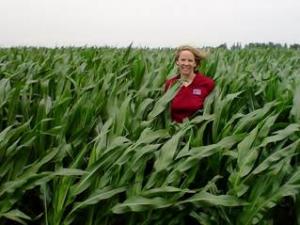It was July 13 – just last Saturday – and the corn on Deb Keller’s farm near Clarion, Iowa, had yet to grow taller than her 5 feet 9 inches height, let alone begin to tassel. The old “knee-high by the Fourth of July” line about judging the growth of corn? Some of her fields didn’t make it.
“I’m probably in one of the worst hit parts of the state,” Keller said about her 2013 corn crop. The cool, late spring gave way to rain that just hung around North Central Iowa. “It just kept getting later and later, but we gambled and went ahead and planted corn, finishing up June 18. Normally we’re done planting by May 10.”
She said about 10 percent of what was supposed to be corn in her area never got planted because it was so late. “Other parts of Iowa look a lot better,” she said, “but we need a late frost to give the corn time to mature; final yields will depend on it. The average frost date is Oct. 5, but we’ve seen it as early as the third week of September. In either case, I’m betting farmers will need their grain dryers in Iowa this year to get the crop dried down after harvest.”
Heat finally arrived in early July, helping kick corn growth into high gear, with significant maturing over the last two weeks. Keller said the corn plants are looking good, with not a lot of insect pressure yet, although rootworm season is just gearing up. Another item she’s keeping an eye out for is Goss’s wilt, which can cause some wilt and leaf blight in the plants.
In an average year, Keller said they’d see corn yields push 200 bushel per acre – but she’s hoping to get 140 bushel per acre this year, compared to last year during the drought when the farm averaged 155 bushel.
Across the state, as of July 14, the U.S. Department of Agriculture said 67 percent of the Iowa’s corn crop was in good to excellent condition, 30 percent was average and 13 percent was poor to very poor. A year ago, only 36 percent was good to excellent, while 37 percent was fair and 27 percent was poor to very poor.
Keller said she’s originally from eastern Indiana that family there is “having the best crop in years.” While parts of Iowa may be off this year, she said, other states are in excellent shape to help produce a big crop across the country. “We’ll have corn for sale on the global market come fall,” she said.
Nationally, USDA said 66 percent of the U.S. corn crop was in good to excellent condition as of July 14, with 25 percent average and 9 percent poor to very poor. Even though this year’s crop is a couple weeks behind last year, it’s in much better condition. A year ago at this time, only 31 percent of the country’s crop was rated good to excellent, while 31 percent was average and 38 percent poor to very poor.
“The next couple of weeks are pretty important as we enter the pollination phase,” Keller said. “Hopefully we’ll have good weather and be in a good position as the crop matures.”

